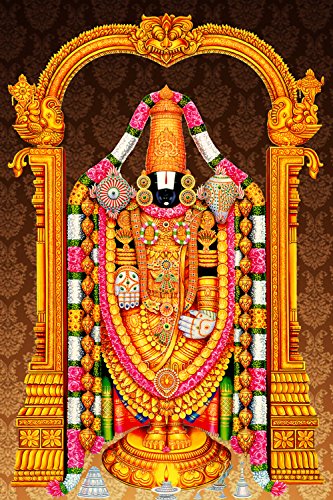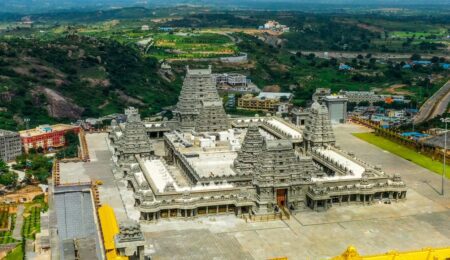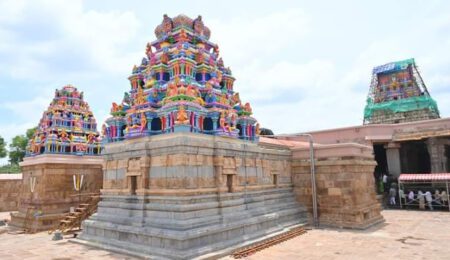Lord of Balaji: The Eternal Light of Tirumala
Lord of Balaji
Introduction – Lord of Balaji : A Divine Call from the Hills of Tirumala
High above the bustling plains of Andhra Pradesh, nestled in the sacred folds of the Seshachalam Hills, lies a temple that has drawn pilgrims for centuries the Tirupati Balaji Temple, home to Lord Venkateswara Swamy, the beloved deity of Kali Yuga. Known by many names Balaji, Govinda, Srinivasa, and Perumal he is revered as the living embodiment of Lord Vishnu, who descended to Earth to protect dharma and uplift humanity.
To walk the path to Tirumala is to walk into a timeless embrace. The air hums with chants of “Govinda! Govinda!”, echoing through the hills like a celestial mantra. Devotees arrive with shaved heads, bare feet, and hearts full of longing seeking blessings, healing, and moksha. The moment one beholds the idol of Balaji, carved from black granite and adorned with dazzling ornaments, a profound stillness descends. His eyes, partially veiled, seem to look beyond lifetimes. His Shankha and Chakra radiate cosmic energy, while the golden Tilaka glows with divine assurance.
This is not merely a temple. It is Bhooloka Vaikuntha Vishnu’s abode on Earth. It is a sanctuary of faith, a beacon of hope, and a spiritual powerhouse that transcends caste, creed, and geography.
Historical Origins of Lord Venkateswara
Puranic Mentions and Scriptural Roots
The origins of Lord Venkateswara are deeply embedded in the Puranas, which describe his descent during the Kali Yuga to restore balance and protect devotees. The Bhavishya Purana, Padma Purana, Varaha Purana, and Skanda Purana all reference the sacred Venkatachala Hills as the site of Vishnu’s earthly manifestation.
The name “Venkateswara” itself is derived from two Sanskrit words:
- “Venkata” – the name of the hill
- “Ishwara” – meaning Lord or Supreme Being
Together, they signify “The Lord of Venkata Hills,” a title that reflects both geographical sanctity and divine authority.
Temple Development Through Dynasties
The Tirumala temple has evolved over centuries, shaped by the devotion and patronage of various South Indian dynasties:
- Pallavas (4th–9th century CE): Early references to the temple appear in inscriptions from the Pallava period, indicating its growing prominence.
- Cholas (9th–13th century CE): The Cholas contributed to temple architecture and rituals, establishing a strong Vaishnavite tradition.
- Vijayanagara Empire (14th–17th century CE): Under Krishna Devaraya, the temple flourished. He donated gold, commissioned the Ananda Nilayam Vimana, and institutionalized many of the sevas and festivals still practiced today.
Inscriptions in Tamil, Telugu, Kannada, and Sanskrit found within the temple complex testify to its pan-Indian significance and multicultural legacy.
Mythology and Legends of Tirupati Balaji
The Bhrigu Rishi Legend – A Cosmic Test
One of the most profound legends associated with Lord Venkateswara is the tale of Sage Bhrigu, who was tasked with determining the greatest among the Trimurti Brahma, Vishnu, and Shiva.
- Bhrigu visited Brahma and Shiva, both of whom failed to acknowledge him.
- Upon reaching Vishnu, who was resting with Lakshmi at his feet, Bhrigu kicked Vishnu on the chest in anger.
- Vishnu, instead of retaliating, gently massaged Bhrigu’s foot, calming him.
- Lakshmi, however, was deeply hurt and left Vaikuntha, descending to Earth.
To reunite with Lakshmi, Vishnu incarnated as Venkateswara, choosing the Tirumala Hills as his abode. This legend underscores Vishnu’s humility and compassion, and the temple’s role as a place of divine reconciliation.
The Divine Marriage of Padmavati
Another cherished legend is the celestial wedding of Venkateswara and Padmavati, an incarnation of Lakshmi.
- Padmavati was born to King Akasa Raja of the Chola dynasty.
- Venkateswara, in his earthly form, fell in love with her and sought her hand in marriage.
- To fund the wedding, he borrowed wealth from Kubera, the god of riches a debt that devotees symbolically help repay through offerings.
The marriage is celebrated daily in the temple as Kalyanotsavam, where devotees participate as symbolic family members of the divine couple.
The Origin of the Idol and Temple
According to lore, the idol of Venkateswara was discovered by a shepherd, guided by divine visions. The idol is believed to be Swayambhu (self-manifested), not sculpted by human hands. The temple was built around this miraculous form, and its sanctity has only grown with time.
Symbolism of the Idol – The Divine Form of Venkateswara
The idol of Lord Venkateswara Swamy is not merely a sculpture; it is a cosmic embodiment of Vishnu’s energy, carved from black granite, believed to be Swayambhu (self-manifested). Every element of the idol carries profound spiritual symbolism.
Shankha and Chakra – Eternal Guardians of Dharma
- The Shankha (conch) in the left hand symbolizes the primordial sound “Om,” the vibration from which the universe was born. It represents purity, auspiciousness, and the call to righteousness.
- The Chakra (discus) in the right hand is the Sudarshana Chakra, a weapon of cosmic order. It signifies time, protection, and the destruction of evil.
Together, they remind devotees that the Lord is both compassionate and powerful the protector of dharma and the destroyer of adharma.
Tilaka and Covered Eyes – Mystical Grace
- The Tilaka on Balaji’s forehead is a golden U-shaped mark, representing the feet of Vishnu. It is flanked by two vertical lines, symbolizing Lakshmi and Bhudevi.
- His eyes are partially covered with a golden strip. According to tradition, the Lord’s gaze is so intense and powerful that it could overwhelm devotees. The covering ensures that his grace is received gradually and gently.
Ornamentation and Alankaram – Divine Splendor
- The idol is adorned daily with diamonds, gold, pearls, and silk, reflecting the grandeur of Vaikuntha.
- Each day, the Alankaram (decoration) changes, symbolizing different aspects of Vishnu from the warrior protector to the gentle consort of Lakshmi.
The black granite form, standing tall and serene, evokes a sense of timelessness. It is said that even a moment’s darshan can dissolve lifetimes of karma.
Temple Traditions and Daily Rituals
The Tirumala Tirupati Temple operates with a precision and sanctity that reflects centuries of devotion. Managed by the Tirumala Tirupati Devasthanams (TTD), the temple follows a strict schedule of rituals, sevas, and offerings.
Suprabhatam – Awakening the Lord
- The day begins at 3:00 AM with the chanting of Suprabhatam, composed by Prativadi Bhayankara Annan.
- The verses gently awaken the Lord, inviting him to bless the devotees waiting outside.
Thomala Seva and Archana
- Thomala Seva involves adorning the deity with garlands of fresh flowers.
- Archana is the recitation of the Lord’s 108 names, invoking his blessings for all beings.
Kalyanotsavam – The Divine Wedding
- Held daily, this ritual reenacts the marriage of Venkateswara and Padmavati.
- Devotees can participate by purchasing tickets, symbolically becoming part of the divine family.
Ekantha Seva – The Final Offering
- At night, the Lord is put to rest with lullabies and offerings.
- The sanctum is closed, and the deity is left in solitude until the next morning.
Hair Tonsure – Surrender and Gratitude
- One of the most unique traditions is Mokku, where devotees shave their heads as an act of surrender.
- It symbolizes shedding ego, offering oneself completely to the Lord.
Major Festivals Celebrated at Tirumala
The temple calendar is filled with vibrant festivals that draw millions of devotees. Each celebration is a blend of spiritual fervor, cultural richness, and divine grace.
Brahmotsavam – The Grand Celebration
- Held annually in September–October, Brahmotsavam is a nine-day festival believed to be initiated by Lord Brahma himself.
- The deity is taken out in processions on various vahanas (vehicles) Garuda, Hanuman, Elephant, Horse each symbolizing different cosmic forces.
- The streets of Tirumala come alive with music, dance, and devotion.
Vaikuntha Ekadasi – Gateway to Heaven
- Celebrated in December–January, this is the most auspicious day for Tirumala Darshan.
- The Vaikuntha Dwaram, a special entrance to the sanctum, is opened only on this day.
- Devotees believe that passing through this gate grants liberation and entry into Vaikuntha.
Rathasapthami and Pushpayagam
- Rathasapthami marks the Sun God’s chariot ride and is celebrated with processions.
- Pushpayagam involves offering thousands of flowers to the deity, symbolizing nature’s devotion.
Architectural Grandeur of Tirupati Balaji Temple
The temple is a masterpiece of Dravidian architecture, blending spiritual symbolism with artistic excellence.
Ananda Nilayam Vimana – The Golden Tower
- The sanctum is crowned by the Ananda Nilayam Vimana, a gold-plated tower that glows under the sun.
- It represents the blissful abode of Vishnu and is visible from miles away.
Gopurams and Mandapams
- The temple has several gopurams (gateway towers), each intricately carved with deities, animals, and celestial beings.
- The Ranga Mandapam, Kalyana Mandapam, and Dhvajastambha Mandapam serve as venues for rituals and gatherings.
Sacred Geography – The Seven Hills
- Tirumala is located on Saptagiri, the seven hills representing the seven heads of Adisesha, the serpent on whom Vishnu rests.
- Each hill is named after a virtue Seshadri, Neeladri, Garudadri, Anjanadri, Vrishabhadri, Narayanadri, and Venkatadri.
Cultural Impact and Global Presence
Influence on Arts and Devotional Literature
- The temple has inspired thousands of Carnatic compositions, especially by Annamacharya, who wrote over 32,000 songs in praise of Balaji.
- Bharatanatyam, Kuchipudi, and Harikatha performances often center around Venkateswara’s stories.
International Temples and Diaspora Devotion
- Temples modeled after Tirumala exist in New Jersey (USA), Sydney (Australia), London (UK), and Nairobi (Kenya).
- These temples replicate rituals, festivals, and even distribute Laddu Prasadam.
Donations and Philanthropy
- TTD receives billions in donations, making Balaji the richest deity in the world.
- Funds support free meals (Annadanam), education, healthcare, and cultural preservation.
Spiritual Relevance in the Modern Era
A Sanctuary for All
- In a world of chaos and uncertainty, Lord Venkateswara offers solace, clarity, and strength.
- Devotees from all walks of life from farmers to CEOs find peace at his feet.
Digital Devotion and Global Access
- TTD has embraced technology with online booking, virtual darshan, and live streaming.
- Devotees can participate in sevas, donate, and even receive prasadam through digital platforms.
The Debt to Kubera – A Symbol of Eternal Offering
- The legend of Venkateswara’s loan from Kubera reminds devotees that offerings are not transactional they are acts of love and gratitude.
- Every coin dropped in the Hundi is a gesture of devotion, helping repay the divine debt.
Frequently Asked Questions (FAQs)
What is the historical origin of Tirupati Balaji Temple?
The temple’s origins trace back to ancient times, with references in the Bhavishya, Padma, and Skanda Puranas. It gained prominence under the Pallavas, Cholas, and Vijayanagara Empire, especially during the reign of Krishna Devaraya, who contributed significantly to its architecture and rituals.
Why is Lord Venkateswara considered the deity of Kali Yuga?
According to scriptures, Vishnu incarnated as Venkateswara to guide devotees during the spiritually challenging age of Kali Yuga. His presence on Earth is seen as a beacon of hope, compassion, and moksha for those struggling with worldly suffering.
What is the significance of hair tonsure at Tirumala?
Hair tonsure (Mokku) is a symbolic act of surrender. Devotees offer their hair to the Lord as a gesture of humility, gratitude, and detachment from ego. It is one of the most visible and heartfelt traditions at Tirumala.
How can I book Tirumala Darshan?
Visit the official TTD website to book:
- Special Entry Darshan (₹300)
- Free Darshan (Sarva Darshan)
- Seva tickets for rituals like Kalyanotsavam, Thomala Seva, etc.
Advance booking is recommended due to high demand, especially during festivals.
What is Laddu Prasadam and how can I get it?
Tirupati Laddu is a sacred offering made in the temple’s kitchen. It is distributed to devotees after darshan and is also available for online booking and delivery in select regions. It holds a GI tag, symbolizing its unique heritage.
What is Vaikuntha Ekadasi and why is it special?
Vaikuntha Ekadasi is celebrated in December–January and marks the opening of the Vaikuntha Dwaram, a symbolic gateway to Vishnu’s heavenly abode. Darshan on this day is believed to grant liberation and divine blessings.
How can I donate to Tirupati Balaji Temple?
Donations can be made:
- Online via the TTD portal
- In person at temple counters
- Through authorized banks and donation schemes
Offerings support Annadanam, education, healthcare, and temple maintenance.
Are there international Tirupati Balaji temples?
Yes. Temples modeled after Tirumala exist in:
- New Jersey (USA)
- Sydney (Australia)
- London (UK)
- Nairobi (Kenya)
These temples replicate rituals, festivals, and even distribute Laddu Prasadam, connecting global devotees to Tirumala traditions.
Conclusion – The Eternal Embrace of Govinda
To speak of Lord Venkateswara Swamy is to speak of eternity wrapped in compassion. His temple atop the Saptagiri Hills is not just a structure of stone and gold it is a living testament to faith, resilience, and divine love. Millions climb those hills not for miracles alone, but for the quiet assurance that someone divine walks with them, listens to their prayers, and lifts their burdens.
In the black granite form of Balaji, we see the paradox of divinity silent yet expressive, distant yet intimately close. His gaze, though veiled, penetrates the soul. His rituals, though ancient, resonate with modern seekers. His festivals, though grand, touch the simplest hearts.
Whether you are a pilgrim seeking moksha, a devotee offering gratitude, or a curious traveler drawn by legend, Tirupati Balaji Temple welcomes you. It whispers the timeless truth: that in surrender, there is strength; in devotion, there is clarity; and in the feet of Govinda, there is liberation.
So come climb the hills, chant his name, offer your heart. The Lord of Balaji awaits, not just in Tirumala, but in every moment of faith.




Leave a Comment